Hallasan Mountain is the central point of Jeju, South Korea‘s largest island. The top of this shield volcano is also the highest peak in the country. But that is not the main reason that makes Hallasan Mountain hike attractive.
The stunning nature of Hallasan National Park, a UNESCO-recognized Biosphere Reserve and World Heritage Site, gives Hallasan hiking trails an aura of exceptional beauty. Experiencing this environment provides a sense of fulfillment that the pure fact of conquering the highest South Korean summit cannot compare with.
Jeju has been a dream destination for Asian tourists even before Kang, the North Korean defector in Netflix‘s popular drama series “Squid Game”, expressed her fantasy about visiting the island if she survived the bizarre Korean version of the “Hunger Games”.
Hallasan hiking trails lead through places of exceptional beauty on the volcanic island of Jeju
With a myriad of available Jeju Island activities, whether you are exploring waterfalls and lava tubes, enjoying the island’s unusual coastline, relaxing in a range of authentic Korean spa bathhouses, or visiting the infamous sex park Jeju Loveland, the Korean Hawaii is a place that generates excitement.
Nothing, however, tops hiking to the top of Hallasan Mountain, the extraordinary volcano that enabled the birth of Jeju Island.
In this detailed guide, you will learn facts and legends surrounding this mystical place, find out my recommendations on the best Hallasan trails and how to get to Hallasan Mountain depending on your trail choice, as well as take away practical advice on conquering the highest mountain in South Korea.
Quick travel links
🏨 Hotels & more
Find best options with Klook
🚅 Transportation
Get your tickets on 12Go
🗺️ Make trips memorable
Book new activities with GetYourGuide
How many mountains are there in South Korea?
With 70 % of its territory covered in mountains and highlands, we could say that South Korea is dominantly a mountainous country.
Its two major mountain ranges are the Taebaek Mountains (following the eastern shore of South Korea) and Sobaek Mountains (in the west-central part of the peninsula), with sometimes additionally highlighted Jiri Massif, home to the highest peak on the South Korean mainland (Jirisan, 1.915 m).
In total, there are 7.715 named mountains in South Korea. While numerous, they are not particularly high, with most summits under 1.000 meters.
You can touch the sky in Seoul too - visit its ecological oasis, the Haneul Sky Park!
How high is Mount Hallasan?
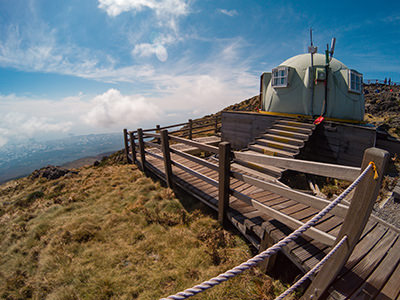
Hallasan mountain’s height reaches 1.947 meters above sea level. That makes it the tallest mountain in South Korea. It can be seen from any point on Jeju Island and, on a clear day, even from the mainland.
Locals often call Hallasan – Yeongjusan, which we could translate as “a mountain high enough to pull the galaxy”.
Where exactly is Hallasan Mountain?
Hallasan Mountain is located in the middle of the island of Jeju, the southernmost point of South Korea in the East China Sea.
How old is Mount Hallasan?
The formation of Mount Hallasan on a lava plateau dates back to the Pliocene epoch, more than 2,5 million years ago. The 2017 research on determining the age of the summit crater rock by optically stimulated luminescence, revealed that the current shape of Mount Hallasan was formed between 37 and 20 thousand years ago.
How was Mount Hallasan formed?
Hallasan Mountain, just like the entire Jeju Island, is a direct result of volcanic activity. It was formed by the eruptions of basalt and trachyte lava.
Is Hallasan an active volcano?
Scientists don’t always agree on the definition of an active volcano. If we accept the ruler of the Smithsonian Institution’s Global Volcanism Program which defines activity in a timeframe of 10 thousand years, we would have to say that Hallasan is not a dormant nor extinct volcano.
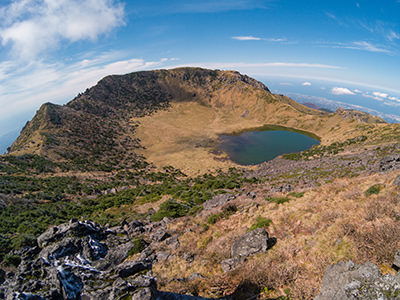
The most recent research from 2014 has radiocarbon dated the charcoal below the basalt layer as 5.000 years old. This means that the Hallasan volcano erupted after the last ice age, so it should be classified as active.
Additionally, there are historical records from the Joseon Dynasty noting the 11th-century events, the location of which has not yet been determined: “In June 1002 CE, a mountain arose in the middle of the sea. There were four giant holes at the top of the mountain, out of which red liquid flowed and soared, and thick smoke plumed for five days. All the red liquid hardened and became stone like roof tiles.”
Hallasan’s last eruption might have been one or five thousand years ago, and the current lack of activity might suggest its dormant phase, but there have been erupting examples of even volcanoes deemed extinct. Therefore, while it is highly unlikely that a sudden eruption could spoil your Jeju holidays, one should still treat the Hallasan volcano like an unpredictable active volcano.
One of the greatest eruptions in world history happened on a postcard-perfect Greek island. Read more about Santorini, the place with a magical sunset.
What is Hallasan Mountain famous for?
Besides being the highest mountain in South Korea, thus making it a landmark of national significance, there are other elements that define Hallasan Mountain as a prime hiking destination.
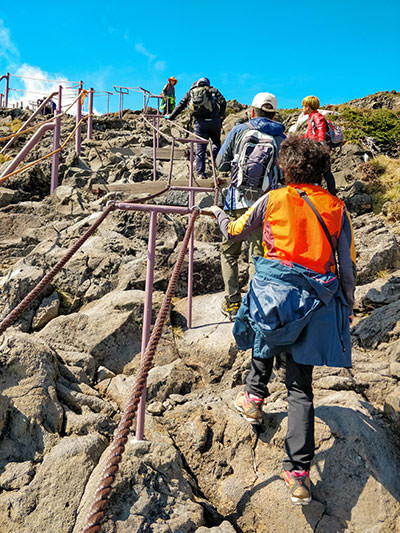
In addition to the large volcanic crater on the top of the mountain – Dongneung Peak (Baengnokdam), Hallasan is surrounded by smaller parasitic cones, called oreum in the Jeju dialect. With 368 of them sprinkled around the mountain, this is the world’s largest ‘Oreum Kingdom’. Oreums here are mostly cinder cones, with some lava domes and tuff rings.
Hallasan’s geological value is directly connected with its biological wealth. As temperatures fall with elevation, the climate zones change too. This enabled the development of a variety of species, from subtropical to alpine.
The vertical ecosystem of plants includes some 2.000 species, out of which 73 are indigenous, many endangered, and rare. There were even legends of Korean wizards who became immortal after consuming an endemic Hallasan plant. Qin Shi Huang, the first emperor of unified China (221-210 BC), sent men to retrieve the sacred plant so he could live forever too.
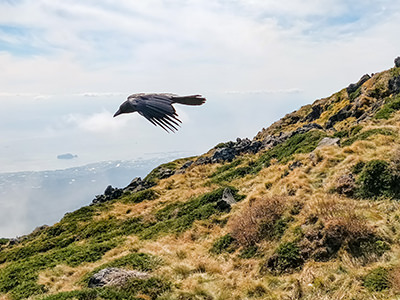
Besides the plant diversity, the environmental gradient on Hallasan Mountain also enabled the coexistence of polar and tropical animals in a relatively small area. The mountain is shared by 4.000 animal species, including 160 resident bird species and 3.315 kinds of insects. The largest mountain animal is the roe deer, the symbol of Hallasan, which recovered after being on the edge of extinction.
Both flora and fauna are protected in Hallasan Mountain Natural Reserve as Natural Monument no. 182 since 1966, as National Park since 1970, as UNESCO Biosphere Reserve since 2002, as World Heritage Site since 2007, and as Global Geopark since 2010.
Explore Jeju island on a small-group tour
Sacred mountain worth killing for
Beyond natural treasures, Hallasan Mountain also has a spiritual significance to Koreans. As one of the three South Korean spirit mountains (the other two being Jirisan and Seoraksan), Hallasan is considered sacred. Koreans believe that gods and spirits live in the mountain, so they worship it and pray there.
Hallasan Mountain is also home to Gwaneumsa, the oldest Buddhist temple on the island, dating back to the 11th century. It was destroyed in 1702, during the Joseon dynasty when Confucianism was established as the national religion, but it was rebuilt in the early 20th century.
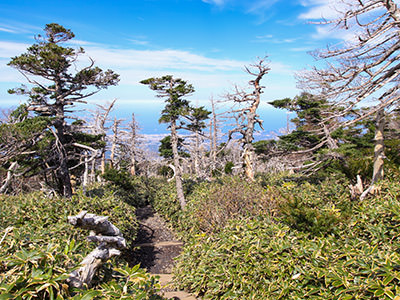
When the first western visitors started arriving at Jeju Island in the late 19th century, hoping to climb Hallasan, locals informed them that nobody has ever been to the summit.
Jeju governor Yi Chi-ho rejected German journalist Siegfried Genthe in 1901 with these words: “The mountain spirits would surely plague the island with bad weather, thunderstorms, poor harvest and pestilence if anyone were to approach them and disturb their rest. A bad harvest would cause the people to blame you, the foreigner, and no doubt would result in your physical harm.”
With a bloodthirsty massacre of Korean Christians earlier that year, the island that hated foreigners seemed ready to do whatever it takes to protect their beliefs.
Despite of the fact that they live in a harsh environment, the people of Afar in Ethiopia defended the Erta Ale volcano with their lives too. Even if it meant chopping off testicles of uninvited visitors, they were always ready to protect Danakil depression, the hottest place on Earth.
How to hike Hallasan Mountain?
Luckily, hiking Mt. Hallasan today is a child’s game in comparison to achieving the same in the hostile environment a century ago. Well, at least permit-wise.
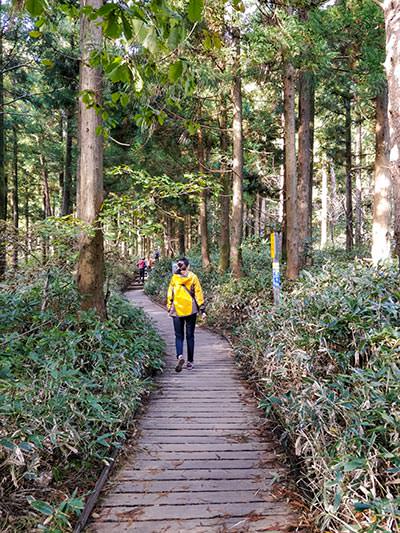
While there is no entry fee for the Mt. Hallasan hike, in recent years, booking a spot for your visit is mandatory through their reservation system. You can secure your pass for dates in a current and an upcoming month. They disappear fast, especially on the weekends, so do it as soon as you know your hiking dates!
While the website technically comes in the English language, you will need to select a trail name written in Korean. So pin this article, in order to know what you are choosing, you’ll thank me later!
The trails you can pick are Seongpanak or 성판악, and Gwaneumsa or 관음사. Hiking trails that do not reach the summit of Hallasan Mountain do not require a reservation.
You only need to reserve the trail you’ll use for the ascend (for Seongpanak, there are 1.000 daily permits, and for Gwaneumsa 500). When descending the mountain, you can choose the pathway on the spot.
If you love nature and especially cliff hiking, I have a special recommendation for you. I have found some of the best hikes - in Norway!
Hallasan summit
Mount Hallasan summit, also known as Dongneung Peak or Baengnokdam, nests a grassy 108-meter-deep crater with a lake. The crater was formed after the last Hallasan eruption when the top of the ridge collapsed.
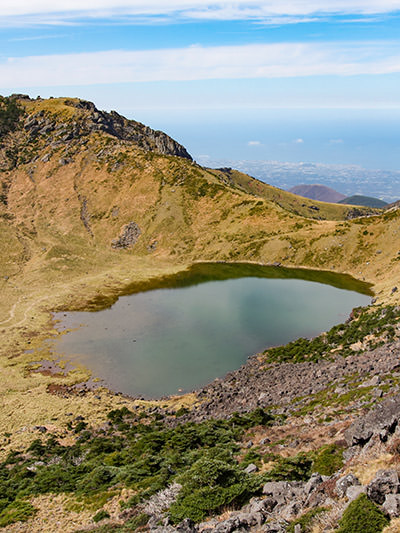
Baengnokdam Lake or White Deer Lake got its name after a mystical white deer that once frequented this place as a drinking ground. Gods living in the mountain, according to the belief, came to ride and play with this white deer.
Another myth explains that the lake is a place where Seolmundae Halmang, the grandmother of the island, fell in never to return. This story conflicts with the one explaining the death of the goddess with a kitchen-style accident (read about it in Yeongsil Trail article section). That is true unless we interpret her cauldron as a crater, filled with a primordial soup that formed Jeju and ate the masterchef alive.
In any case, when on Hallasan peak, you will not have the opportunity to take a closer look into Seolmundae’s kitchen. Descending down the 550-meter-wide crater is not permitted, but views from above are definitely as nice as the close-ups. I’m sure even omnipresent crows would confirm that!
The wooden platform one can observe the volcano from is surrounded by picnic areas where you can consume food you brought yourself. After all, you wouldn’t want to cook it on the spot and provoke the fatal destiny that even goddesses couldn’t escape.
On the top of one Indonesian volcano, there is also a lake but filled with acidic water that could kill you. Learn more about Kawah Ijen volcano, the most toxic place on the planet!
How long does it take to climb Hallasan Mountain?
Depending on the hiking trail you choose to explore, your Hallasan Mountain visit could last anything between 4 and 10 hours. If you want to reach the summit and back and are in reasonably good shape, reserve at least 7 hours of your time.
Is Hallasan a hard hike?
There are short and easy Hallasan trails, but then there are also some that require a higher level of fitness. However, every Hallasan hiking route is shorter than 10 kilometers (one way).
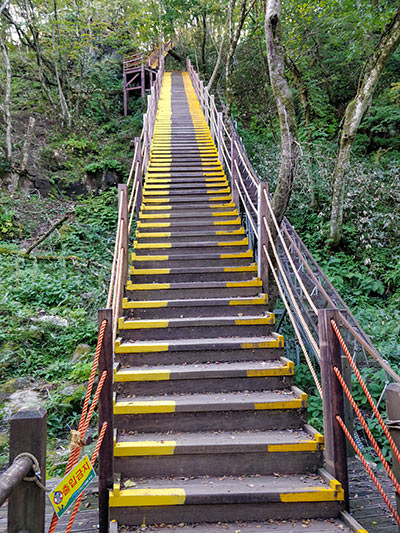
When comparing the two Hallasan routes leading to the mountaintop, Seongpanak Trail is considered to be easier (with only the final part marked as difficult). On the other hand, Gwaneumsa Trail, with steeper and more exhausting sections, is geared towards more advanced hikers.
While you can definitely explore Hallasan trails as return hikes, I suggest combining the two main ones. I climbed up the mountain on a less arduous Seongpanak Trail and descended down the more demanding Gwaneumsa Trail.
While this does seem to be a logical choice, replicated by many visitors, I do have to mention that my knees seriously suffered when going down Gwaneumsa stairs. I almost felt I would have to call for evacuation via the rollercoaster-style monorail following the path.
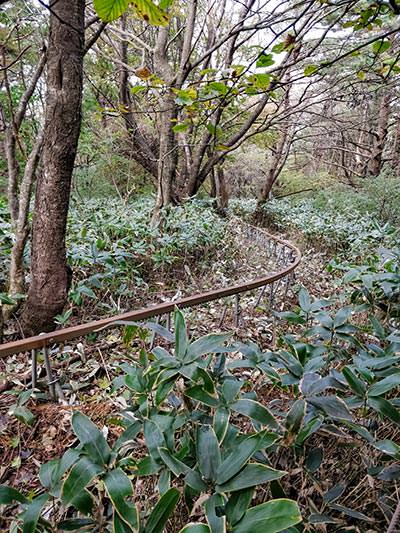
As an early hiker, I was the first one to leave the summit, but among the last ones to exit the trail. I even met the national park ranger browsing the forest and checking for hikers that fell behind.
Both of my knees just gave up during descent, something I never experienced before. In the last portion of my Hallasan hiking route, I could only walk sideways, with completely straightened legs.
The benefit of climbing up Gwaneumsa Trail and descending via Seongpanak Trail is that fewer people do it this way. This means you get the opportunity to enjoy great views without crowds, and less steep come-down in the end. If I return to Hallasan again, I might try this reverse hiking route, and see if my kneecaps would prefer that.
Then again, accidents such as leg fractures are not a strange event even when descending the Seongpanak Trail.
Hallasan Mountain hiking trails
There are five main hiking trails on Hallasan Mountain.
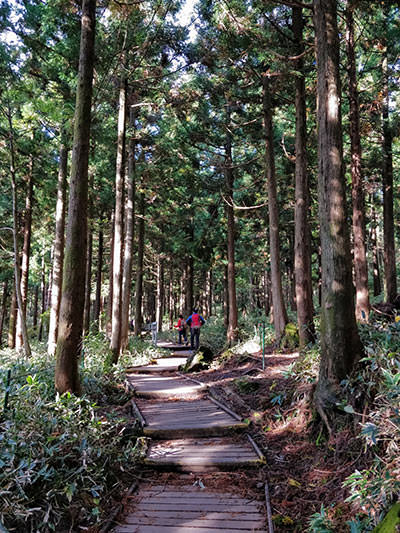
Only two of these trails (Seongpanak, Gwaneumsa) lead to the summit of Hallasan Mountain, connecting to each other on the caldera rim via its eastern ridge.
Until the 1990s, the three hiking trails connecting on the western flank of Hallasan also led to the top but were closed off in that part, so that vegetation could restore. The highest point that Eorimok, Yeongsil and Donnaeko meet at is Witse Oreum, at 1.700 meters.
Before hiking, you should always check the status of the trails you want to use at an official source. Hallasan Mountain trails can close for a varying period of time (from months to years), because of restoration, fire prevention, spring thaw, or general recovery from tourism.
Besides the five main hiking routes presented in this guide, you can also check shorter Hallasan walking trails such as Seokgulam and Eoseungsaengak.
Top 5 Hallasan hiking trails
1. Seongpanak Trail
Length (one way): 9,6 km
Elevation difference: 1.200 m
Time (one way): 4,5 hours
Seongpanak Trail is the longest of Hallasan hiking routes, but it is visitors’ favorite as it follows a gently sloped course.
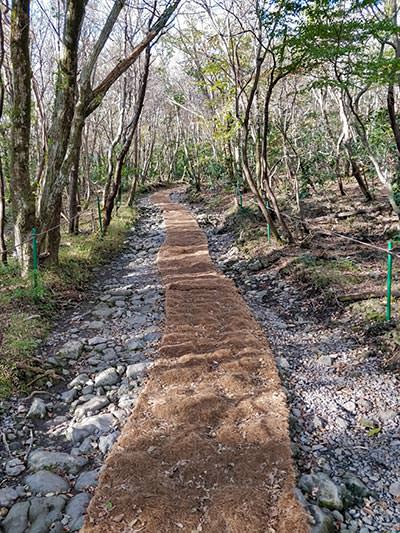
Accessing the mountain from its eastern side, the trail first goes through an evergreen forest of broadleaf trees, partly covered by boardwalks and rope-style carpet that prevents slipping.
Here, you’ll be able to read info boards on the benefits of forest and see signs warning you to watch out for boars. Extinct since the early 20th century, boars reclaimed their mountain territory after some specimens escaped from a local farm. With a bit of luck, you could also spot white-backed woodpecker, badger, and roe deer.
If you want to be sure of conquering the summit, beware of reaching Jindallaebat Shelter, also known as Azalea Field Control Center, before the passing time. If you don’t get there by 12 (from November to February), 13 (from May to August), or 12:30 (in spring and autumn months), you will not be allowed to proceed with the ascent.
The good news is that you’ll be almost there, just 2,3 kilometers to the top, which shouldn’t take more than an hour and a half. Pass the Korean fir colony, and the steep wooden staircase ahead is the last, even if not the least, challenging part of your hike to Baengnokdam.
The side trail to Sara Oreum
Just in between the two shelter stops (Sokbat and Jindallaebat), you will find the pathway branching out south, towards the Sara Oreum.
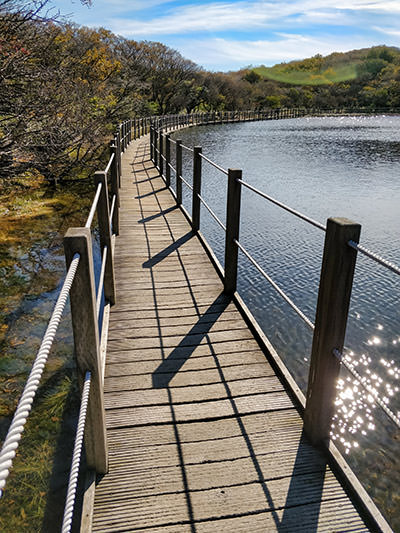
The 600-meter detour to this volcanic cone, designated as scenic spot no. 83 by the Cultural Heritage Administration, will add 40 minutes to your hiking time.
Sara Oreum is home to the Lake of Heaven, a 100-meter-wide crater lake sometimes wrapped in a fog that gives it a mystical appearance. Walking the boardwalk following the edge of the lake, one can admire the marshland adorned with trees such as Siberian crab apple, Japanese strawberry tree, Korean mountain cherry, and Siebold’s spindle tree.
From Sara Oreum Observation Deck, the views open up to the southern sea, as well as the eastern ridge of Mt. Hallasan. It’s a serene place for just sitting and observing.
How to get to Seongpanak Trail?
Personally, I rented a car, parked it at the Seongpanak Trail start, and then, after the hike, used a taxi and bus to get back to my car from the Gwaneumsa finish line. While renting your own car gives you more freedom for planning, you can access Seongpanak Trail by public transport too. Direct buses heading to the trailhead are 181 from Jeju City and 182 from Seogwipo.
2. Gwaneumsa Trail
Length (one way): 8,7 km
Elevation difference: 1.330 m
Time (one way): 5 hours
Gwaneumsa Trail accesses Hallasan Mountain from its northern side, offering views of deep valleys as well as outstanding mountain features.
Close to the famous Buddhist temple it got its name from, the start of Gwaneumsa Trail is marked by Gwaneumsa Camping Site which can accommodate up to 1.000 visitors. If you feel like starting your Hallasan hike as soon as the trail opens (5:00 in summer, 6:00 in winter, 5:30 in spring and autumn), this is the perfect place to spend the night or take a shower after a descent.
There is also a selection of outdoor workout equipment at the trailhead, in case you feel like warming up for the most difficult Hallasan hiking route.
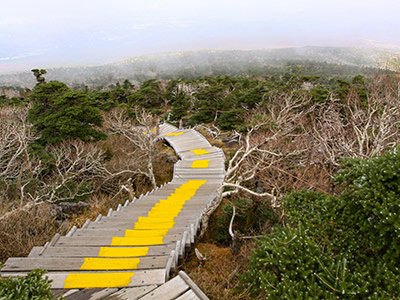
It’s not the longest hiking trail on Hallasan, but it takes the most time to complete. Steeper parts leading to Samgakbong Shelter, and the final ascend to the summit, are those that slow hikers the most.
The first part (in the case that you chose Gwaneumsa Trail for ascending, unlike me) goes through quite an enjoyable area suitable for forest bathing. There are 50 species of trees on this trail, and they hide an entire world of ferns and herbaceous plants successfully fighting for a small amount of sunlight sprinkling through the canopies.
Bird lovers will enjoy spotting a variety of feathered residents of this forest, such as jungle crows, great spotted woodpeckers, bulbuls, chickadees, wrens, and even more magical summer visitors such as fairy pittas, paradise flycatchers, yellow-rumped flycatchers, blue-and-white flycatchers, and so on. On the forest floor, look for long-tailed pangolins!
Lava tube, hanging bridge, and countless stairs
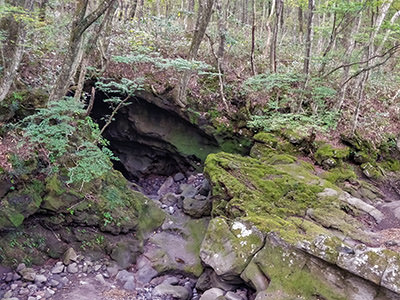
After half an hour on Gwaneumsa Trail, you will reach Guringul Cave, home of bats and other cave animals. Essentially a lava tube cave, formed by lava flow, this 442 meters long and 3-meter-wide work of mother nature was used as an ice storage facility in ancient times, essentially a freezer of our ancestors. You are not able to enter Guringul, but there are 130 lava tube caves on the island, and you should definitely visit Manjanggul, as recommended in my list of top things to do in Jeju.
Next, you’ll pass Tamnagyegok Valley and Mokgyo Bridge. From there on the hike starts to get more challenging. The yellow-tipped stairs might not lead you to Dorothy‘s Oz, but once you manage to catch your breath, the scenery will become magically rewarding. Expect wooden pathways surrounded by impactful backgrounds (flowers, foliage, or snow, depending on the month of your visit), unusual rock formations, and the beauty of living and dying trees.
Remember though that you will need to be at Samgakbong Shelter before the cutoff time if you want to reach the Hallasan Mountain summit. Just like with Seongpanak Trail, your deadline will be between 12 and 13 o’clock, depending on the season.
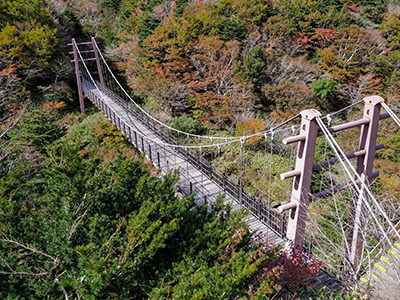
Next, you’ll cross the hanging Yongjingak Hyunsugyo Bridge, and continue along the roughest part of the trail. The last section of the steep climb is 2,7 kilometers long and should take 1 hour and 40 minutes before reaching Baengnokdam along its east ridge.
Even if I climbed Mt. Hallasan in October, I was fascinated to see snow/ice trapped in the branches of the trees on this side of the mountain. Together with an impressive panorama, the ecosystem you witness while taking Gwaneumsa Trail makes all the effort worth it.
How to get to Gwaneumsa Trail?
There is no direct bus line between Jeju City center and Gwaneumsa Trail. You will first need to get to Jeju National University (hop on 181 from Jeju City, or 281 from Seogwipo), and then transfer to bus number 475 at the Jedae Village stop, which will bring you to the trailhead. If you rented a car, you can also park it at the hike start line.
3. Eorimok Trail
Length (one way): 6,8 km
Elevation difference: 630 m
Time (one way): 3 hours
Eorimok Trail approaches Mount Hallasan from the northwest. It starts at Hallasan National Park Office and finishes at Nambyeokbungijeom or South Cliff Fork.
This moderate trail first passes by Eorimok Valley. One-hour walk through the oak tree forest will bring you to Sajebidongsan or Sajebi Hill. Its steep slope demands somewhat higher physical effort, but it’s the only part of the Eorimok Trail marked as difficult.
Another thirty minutes on a stony path, with countryside panorama and oreum views, and you’ll get to Mansedongsan or Manse Hill. From here onwards, it’s a gentle flat terrain.
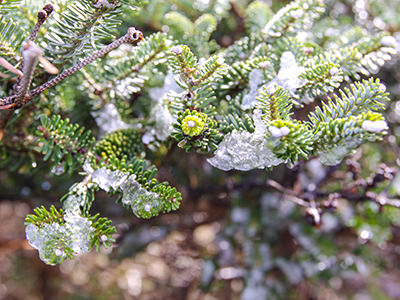
Technically, you could stop your 2-hour hike at Witse Oreum Shelter (1.700 m), the highest point of the trail facing the crater wall of Baengnokdam Lake. The shelter is colloquially referred to as “noodle shack” because hikers traditionally make a lunch break with instant noodles here.
However, for most visitors, Witse Oreum is not the end of the Eorimok Trail. They will continue walking the alpine plain until the Nambyeok junction, finishing the 3-hour trek at an altitude of 1.600 meters.
From the fork of the Nambyeok circuit trail, you could head down the Donnaeko Trail, get back to Witse Oreum Shelter, and change to Yeongsil Trail, or return entirely the same way you ascended the mountain.
When hiking Eorimok Trail, be sure to consult the Hallasan weather forecast, as sudden changes such as fog could affect your experience. If the fog is absent, keep your eyes open for roe deer that frequently appear on the trail, or red royal azaleas covering the meadows in spring.
How to get to Eorimok Trail?
If you plan to use public transport, you should take intercity bus number 240 from Jeju City. Visitors staying in Seogwipo will need to transfer to the same bus, opposite direction, in the Jungmun-do area.
4. Yeongsil Trail
Length (one way): 5,2 km
Elevation difference: 700 m
Time (one way): 2 hours
Yeongsil Trail is the shortest of the main Hallasan hiking trails, and it approaches the mountain from the southwest.
The trail runs from Yeongsil Management Office to Witse Oreum Shelter. If you want to extend your hike to Nambyeok junction, add another hour.
The first part of the trail follows the 2.5-kilometer-long motorway from the office to Yeongsil Service Area, which should take around half an hour to complete. In this section, only vehicles with less than 12 passengers are permitted. This is where renting a car or hailing a taxi comes in handy if you want your trail to be only 3,7 kilometers in length.
After Yeongsil Valley, with the shade of Korean fir trees, mountain streams, and waterfalls, the only demanding part is overcoming the relatively steep slope of Yeongsil Crater ridge. The rest of the hiking trail is an easy stroll over mostly flat terrain.
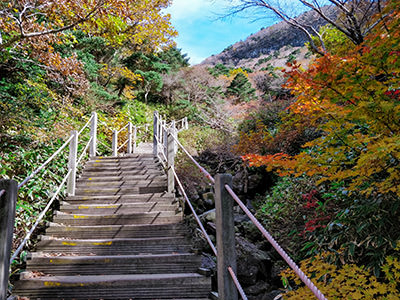
Seonjakjiwat Plain is an exceptional alpine meadow that bathes in pink and red from April to June. The local belief says that shrubs of Hairy Korean rhododendron and Korean azalea in front of the monumental Byeongpungbawi Rock are produced out of the blood of 500 generals.
According to the myth of Jeju’s birth, a gigantic woman Seolmundae Halmang created Mount Halla with seven tosses of a shovel. When this mother of 500 sons cooked a soup for them one day, she fell into the cauldron and died. The sons ate the soup, and when they found their mother’s bones inside, they cried until turning into stone. The large cluster of unusual rock pillars (Obaekjanggun) is visible from Yeongsil Trail, and every spring, the legend explains, their blood revives in form of wildflowers.
How to get to Yeongsil Trail?
Bus number 240 from Jeju City will bring you to the Yeongsil Management Office. Hikers coming from Seogwipo will need to transfer to this bus (opposite direction) from the Jungmun-do area. If you want to skip the 2.5-kilometer hike from the office to the real trailhead, renting and parking a car at the upper Yeongsil Service Area could save you half an hour.
5. Donnaeko Trail
Length (one way): 7 km
Elevation difference: 1.100 m
Time (one way): 3,5 hours
Donnaeko Trail is the only trail approaching Hallasan Mountain from the south, which makes it a convenient starting point for visitors staying in Seogwipo City.
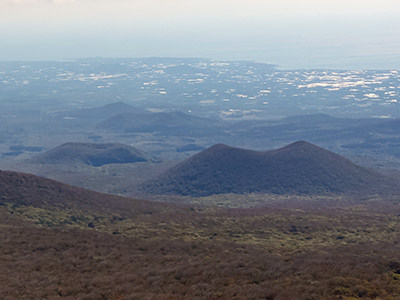
This moderate trail starts at the Visitor Information Center in Donnaeko Amusement Park in Seogwipo and finishes at Nambyeok junction. If you want to extend your hiking experience to the longest Hallasan hiking distance, add another hour to reach Witse Oreum Shelter, and you’ll cover a total of 9,1 kilometers.
Donnaeko got its name after boars that used to come to the valley with cold mountain waters to drink. Today, boars are not around, but you can be the one enjoying a quick dip under the waterfalls in this enchanting part of Jeju.
The real trek starts at the upper area of the recreation grounds. It passes by the Sseogeun-multong pond and broad-leafed forest, the red pine forest of Salchaegido, and then gives a rest opportunity at Pyeonggwe Shelter, surrounded by basalt rocks, lava caves, and lava domes. The final part goes through a subalpine scenery adorned with shrubs, ending at the South Cliff Fork.
The trail has a gentle ascent at the start, and after the shelter, it’s almost flat, which makes it easily accessible to a majority of hikers.
How to get to Donnaeko Trail?
If you are coming from Jeju City, take bus number 181 to Seogwipo Industrial Science High School. From here, take bus number 610-1 to Memorial Cemetery Plaza, and then walk 1 kilometer to the visitor center. If coming from Seogwipo, just hop on the 610-1 bus. A good alternative to finding your way is taking a taxi from the town.
Hiking on Mount Hallasan is the best thing to do in Jeju, even according to Tripadvisor. But there are many more activities to enjoy on the island.
When can I hike Hallasan?
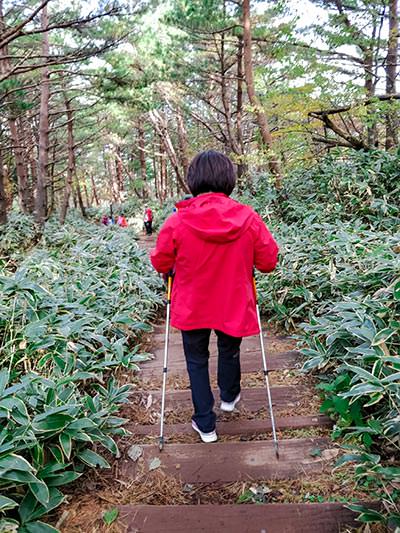
Even if Hallasan hiking trails can close due to bad weather or other reasons, the mountain is generally accessible in every season of the year. That being said, spring and autumn bring the most pleasant weather, and nature gets as colorful as it gets. Of course, if you prefer a monochrome experience, Hallasan Mountain under snow is also enchanting, so opt for a winter hike.
Month choice aside, you should know that staying on Hallasan Mountain overnight is not permitted. As a matter of fact, to prevent unnecessary rescue operations, there is a strict timeframe you should follow when deciding on the hours you will start, continue, or finish your hike.
Do not forget to take into account the time you need for transfer between your accommodation and the trailhead of your choice, which could easily take an hour and a half.
For easier writing, in the following paragraphs, I’ll refer to months from November to February as winter, months from May to August as summer, and months of March, April, September and October as spring/fall.
Opening times
Hallasan Mountain trails open up at 6:00 in winter months, at 5:30 in spring/fall, and at 5:00 in summer.
If you want to be sure to reach the top of the mountain without stress, I wouldn’t recommend starting the hike after 8:30.
Entering the hiking trails is impossible after 12:00 in winter, after 12:30 in spring/fall, and after 13:00 in summer.
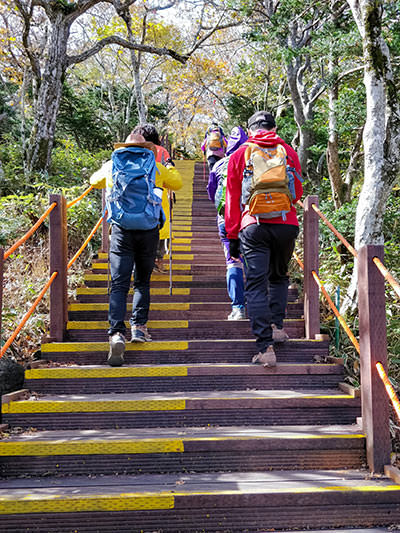
Cutoff times
To guarantee that you’ll manage to reach your final destination, there are also cutoff or turnaround times by which you need to pass the shelters on the route.
On Seongapank Trail, the cutoff time at Jindallaebat Shelter stops climbing at 12:00 in winter, 12:30 in spring/fall, and 13:00 in summer.
On Gwaneumsa Trail, cutoff times at Samgakbong Shelter are the same.
Closing times
The times that rangers will start kicking you out, which means it’s the last moment to start descending, are as follows:
Mount Hallasan summit (eastern ridge) closes at 13:30 in winter, 14:00 in spring/fall, and 14:30 in summer.
Witse Oreum Shelter closes at 15:00 in winter, 16:00 in spring/fall, and 17:00 in summer months.
Nambyeok or South Cliff’s turning point booth closes at 14:00 in winter, 14:30 in spring/fall, and 15:00 in summer.
Hotels near Hallasan Mountain
There is a quite good selection of accommodation options in the vicinity of Hallasan National Park. No matter whether you prefer staying on the northern or the southern coast of Jeju Island, you should be able to find an adequate hotel or a guesthouse.
For even more ideas on places to stay, visit Agoda which offers you accommodations ranging from budget stays to five-star luxury options.
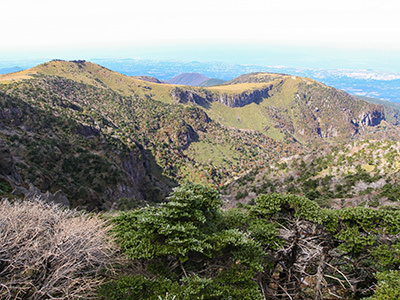
Recommended hotels in the Jeju City area
Hotel Nanta Jeju is a four-star hotel, conveniently close to Hallasan Mountain, and just across the street from Planetarium. The hotel has its own live-performance theater, multiple dining options, fitness facilities, and even two charming dogs. You could stay at this place for already 48 Euros per night. Check the rates for your preferred dates here.
If you are more of a cat person, Amber Resort Jeju has feline pets you will fall in love with. Surrounded by a green lawn, and with a direct view of Hallasan Mountain, you’ll get exposure to the fresh mountain air. Family rooms in private houses are available already from 186 Euros per night. Check the rates for your preferred dates here.
For those who prefer to stay in the heart of Jeju City, Grand Hyatt Jeju is a luxurious 5-star hotel, with indoor and outdoor pools and unbeatable ocean views. Rooms start at 227 Euros but check out the exact rates for your dates here.
A more economical in-town option could be Ganderak Guesthouse. In a convenient location, if you do not have your own transport to reach Hallasan, the 4-bed dormitories come with complimentary breakfast. The prices start at 33 Euros per night. Find the exact rates for your dates here.
Recommended hotels in the Seogwipo area
Donnaeko Pension in Seogwipo offers deluxe double rooms with a fully-equipped private kitchen and bathroom, as well as a communal outdoor swimming pool and garden. Rooms start at 48 Euros per night but check out the exact rate for your dates here.
The Qube Resort Jeju offers spacious studios with ocean and Hallasan Mountain views. With heavy curtains, good sleep is guaranteed, and a buffet breakfast will wake you up in the morning. You can get a room here for 59 Euros per night already. Find out the exact rates for your preferred dates here.
If you are looking for a splurge option, pick Velum Resort. Their rooms come with balconies offering mountain views which you can experience from a bathtub. There is also an outdoor swimming pool, and prices start at 343 Euros per night. Confirm the exact rate for your dates here.
On the economical side, as long as you are fine with staying in the heart of Seogwipo, Bridge Residence Hotel offers great value for money. For as little as 27 Euros, you can get a studio room equipped with cooking and laundry facilities! Check availability for your dates here.
If you love hiking but hate dealing with organizing stuff, maybe you should join a customized private Jeju 7-day hiking tour! For less than 2.000 Euros, you'll get good quality accommodation for an entire week, but also private transfers and a company of a mountain expert on Hallasan hiking trails. During the program, you'll also join a couple of trekking courses along the coast, explore forests and lava caves, and visit other significant natural heritage sites!
Hallasan Mountain hike – Final thoughts
Jeju Island is perfect for exploring on foot. As a matter of fact, Koreans have built a whole network of walking paths, called olle trails, encircling the entire island! It is not a surprise that Hallasan Mountain, the impressive roof of Jeju, comes with its own set of well-organized hiking trails that will lead you to some truly fascinating scenic spots.
When hiking Hallasan, wear sunscreen, layers of clothes, and good shoes
You do have to bring a strong will with you, as while not really mission: impossible, Hallasan hiking trails could take a toll on your physical capacity to conquer the highest Korean mountain.
Take care of your energy reserves, and bring everything you need with you. Snacks and water supplies are a must. If you want to celebrate once you reach the top, Hallasan soju, the local alcohol drink made of fermented and distilled rice and volcanic bedrock water, will be a perfect choice for raising the glass.
Also, beware of sometimes unpredictable Hallasan weather, so always wear a combination of sunscreen, extra layers of clothes, and comfortable and sturdy shoes. Your legs will thank you!
Start your trek as early as possible, and then take your time. Do not obsess with cutoff times, but rather go slowly, and enjoy every minute of your hike through nature’s best artwork! Hallasan Mountain hike will create memories you will carry long after the pain in your knees disappears.
Did you like this guide to Hallasan Mountain hiking trails?
Pin it for later!
Disclosure: This post may contain affiliate links, which means if you click on them and make a purchase, Pipeaway might make a small commission, at no additional cost to you. Thank you for supporting our work!



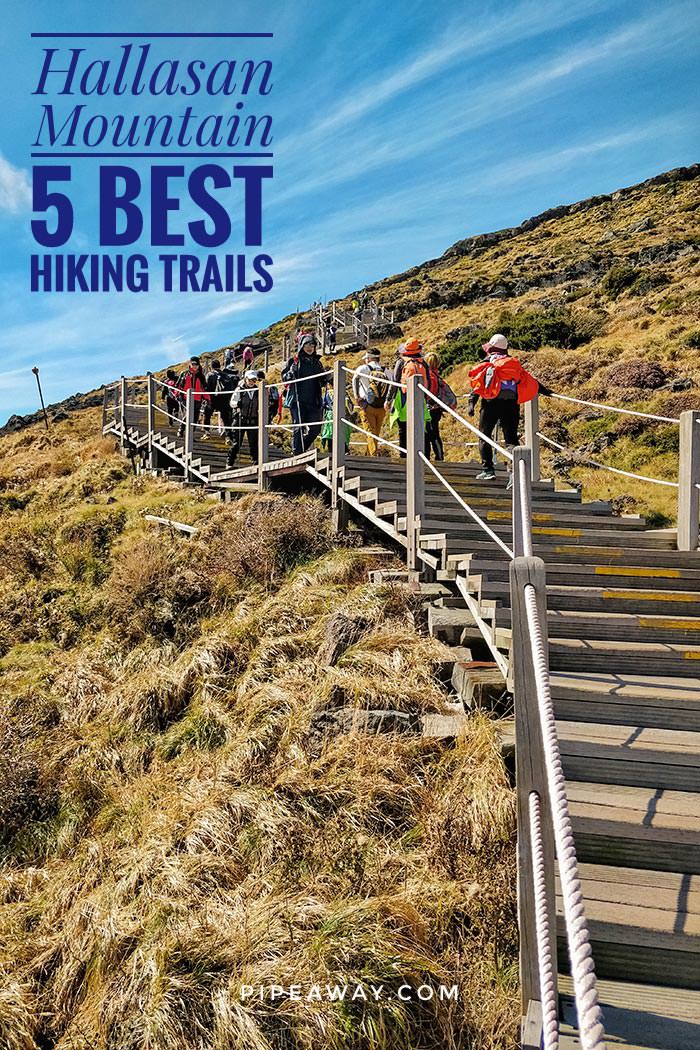
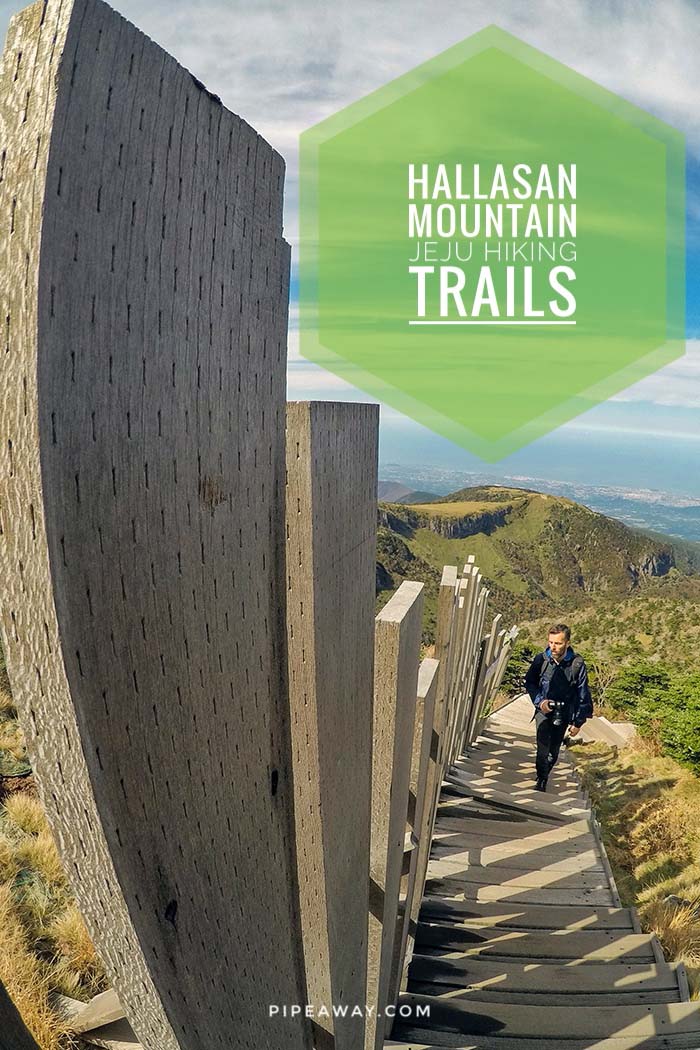

Thank you for sharing such detailed insights about the Hallasan hiking trails! I’m particularly excited about the Seongpanak Trail—your tips about the best viewpoints are super helpful. Can’t wait to hit the trails and enjoy the stunning views!
Thanks! I’m glad that you found this guide through Hallasan trails helpful!
Whichever route you end up choosing, you’ll have a wonderful hike to the peak of Mt Hallasan.
Enjoy your day in nature!